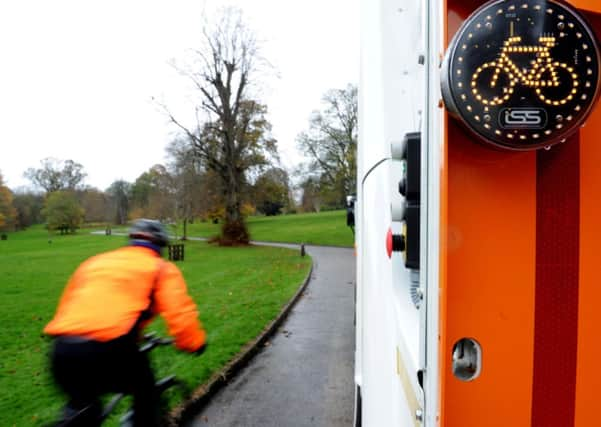Bin lorries get warning signs for cyclists


The technology has been installed on four refuse vehicles owned by Midlothian Council, which has become the first local authority in Scotland to deploy the system.
It works by illuminating a large disc on the rear of the truck warning cyclists it is about to turn left, while using sensors to alert drivers when a bike is drifting too close to the vehicle.
Advertisement
Hide AdAdvertisement
Hide AdIt costs around £1500 to install on each truck. But the move has divided opinion among cycling campaigners, with some hailing the device a “major step forward” for road safety and others branding it a “sticking plaster” in lieu of a real solution.
The Cyclear system, from Innovative Safety Systems Ltd (ISS), is already fixed to refuse lorries in London, Cardiff and Luton.
The device detects only the progressive movement made by the cyclist, eliminating virtually all false alarms.
Cyclist detection systems will be fitted to all appropriate new council vehicles in years to come.
Councillor George Rosie said the authority chose the most up-to-date cyclist warning systems available. He said: “Midlothian Council takes cyclists’ safety very seriously and is extremely conscious of the dangers posed to them when coming into contact with heavy vehicles, especially when turning left.”
It is thought 12 cyclists a year are reported injured in Midlothian roads every year. In 2013, one cyclist died on the B7003 at Roslin Glen.
Transport Scotland figures for 2013 found that across Scotland 882 cyclists were injured – 148 seriously – and 13 cycling deaths. Keith Irvig, chief executive of Cycling Scotland said: “This shows Midlothian Council is taking steps to ensure safety of other road users and these types of initiatives should become standard for all HGV operators.
“Education and practical training is also essential to generating mutual understanding, by putting lorry drivers in the position of those who travel by bike, both in theory and in practice, so that they are much more aware of people on bikes while out on the road.”
Advertisement
Hide AdAdvertisement
Hide AdKim Harding, founder member of cycling campaign group Pedal on Parliament, said the technology would not make a “real difference” until the roads were less dangerous.
He said: “This is more to do with poor sightlines and drivers not looking properly. There should be more investment in making roads safer, such as speed limit measures.”
He added: “However, I do know a cyclist who was hit by an HGV who overtook him and turned left and if it helps reduce that sort of thing then that’s got to be good.”